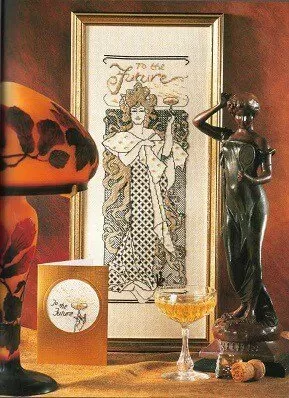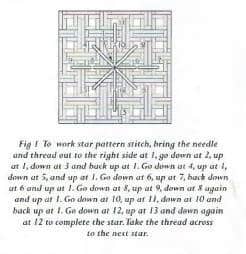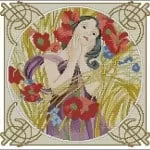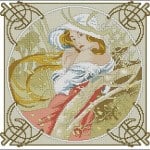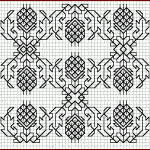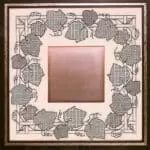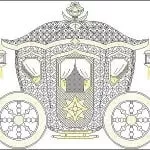Champagne Lady by Alphonse Mucha – blackwork pattern
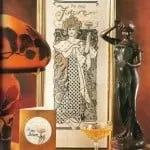
Alphonse Mucha’s art nouveau style is characterised by sensuous ladies with twisting, swirling hair. This
Champagne I.ady Picture and Celebration Card capture his flamboyant style and flowing lines.
In the Champagne Lady, Mucha’s swirling outlines are stitched in back stitch or double running stitch. The black and gold colouring and decorative nature of blackwork seem ed appropriate for this design, so 1 have translated the areas of colour on the poster into different blackwork patterns .Blackwork is a traditional counted technique
made from the same basic stitches as cross stitchers use all the time. Traditionally it was worked on
fine linen but is equally suitable for Aida. All the patterns are created out of basic straight stitches from one hole in the fabric to an adjacent one, either vertically, horizontally o r diagonally.
Blackwork embroidery is traditionally worked in black silt? and decorated with gold or silver thread, gilt spangles and pearls. Here, the black parts are worked with stranded cotton and gold highlights in Kreinik braids. Glass beads represent champagne bubbles and pearly beads add decoration lo the stole.
FINISHED SIZE
Design size: 5,5 x 15,5 in (14 x 39.5 cm) approximately
(mounted in a 8 x 20 in (20 x 51 cm) frame)
Stitch count: 78 x 217
MATERIALS
• 14 x 26 in (35.5 x 66 cm) 14-count cream Aida (for a larger picture, 7 x 20 in (18 x 51 cm) on 11-count
Aida use 15 x 30in (38 x 76cm))
• DMC black (310) stranded cotton, 2 skeins
• Kreinik Fine (#8) Braid 002HL. 2 spools
• Kreinik Very Fine (#4) Braid 002, 1 spool
• Mill Hill gold glass beads 02011. 1 packet
• Mill Hill pearl glass beads 00123, 1 packet
• Size 24 tapestry needle
• Beading needle and cream sewing thread
1 Mark the central horizontal and vertical guidelines on the fabric with tacking . It is best to work this design using an embroidery frame.
2 Begin by outlining the figure and hair in backstitch or double running stitch using two strands of black stranded cotton. Begin near the centre guidelines and beep checking your position. Continue to outline the panel behind the
figure and the glass stem and sides. Avoid carrying threads across areas to be left cream or they may show
through: either finish off and start again or thread the cotton through other stitches o n the back.
3 Work the top and bottom borders in cross stitch, using two strands of black
4 Using backstitch and a single strand of stranded cotton, embroider the curving line behind the head, the
lip of the champagne glass and the lines of the dress which spill over the step.
5 Following the chart and Fig 1. work the star pattern ail over her dress.
6 Using Fine Braid work the hair in two stages. Begin with diagonal back stitches which slope from top right to bottom left. Double running stitch is good for these straight lines. Remember that no stitch should
cover more than one block of the fabric (on the front). Tabe care not to pull this thread too tightly. Parts of her hair have a second diagonal back stitch worked from top left to bottom right: work those parts next.
7 The background pattern is built up from straight lines worked in two strands of black, using a blackwork pattern to achieve a gradual tonal variation. Follow the chart closely for the various parts (see Fig 2 for details).
Part 5 of Fig 2 shows the additional diagonal pattern needed to achieve the darkest tone around the head and left side of the body.
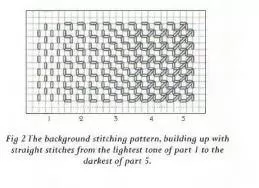
8 Work the facial features, using a single strand of black to define the nose and the outside of the lips and two strands elsewhere. Work the shading under her left elbow with one strand.
9. Remove the guidelines, press carefully then sew on the beads using the beading needle and cream
sewing thread (see chart and Fig 3).
Don’t miss new cross-stitch design with flowers
See also another blackwork patterns

